Evaluating Training & Development Impact on Hilton Hotel Employees
VerifiedAdded on 2022/10/06
|14
|2322
|10
Report
AI Summary
This report investigates the impact of training and development on employee job performance at Hilton Hotels. The research explores the research problem, aim, objectives, and questions, followed by a literature review examining employee job performance, training strategies in the hotel industry, and the effect of training on job performance, including a conceptual framework. The methodology section outlines the research philosophy (positivism), approach (deductive), data collection methods (primary and secondary), sampling, data analysis methods, and timeframe. The study aims to evaluate the effects of training and development on employee job performance, analyze training approaches, investigate implementation issues, and develop recommendations for improved training initiatives to enhance workplace performance. The report utilizes both qualitative and quantitative data analysis techniques, with survey questionnaires and secondary data from sources like Hilton Hotels' annual reports and peer-reviewed journals.
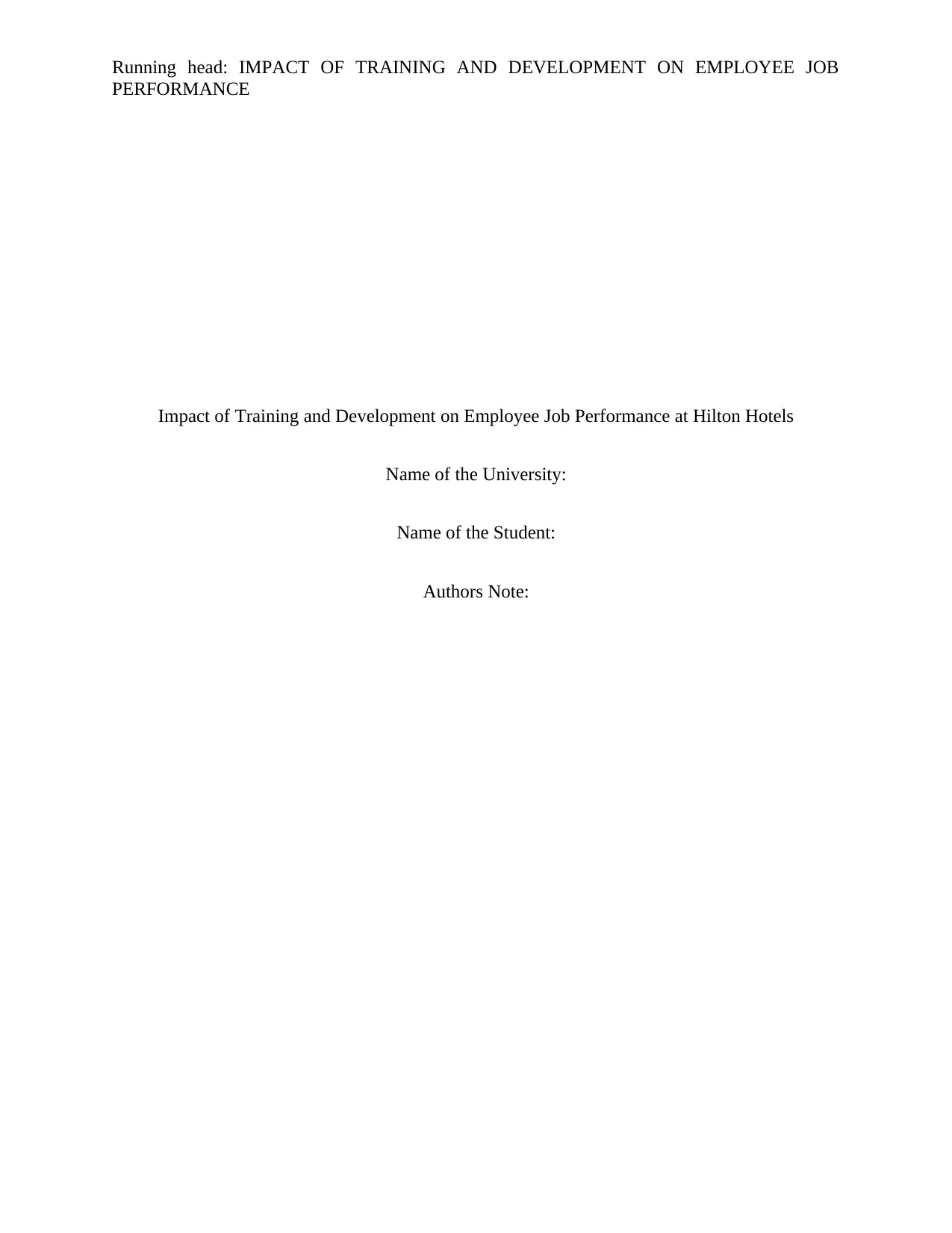
Running head: IMPACT OF TRAINING AND DEVELOPMENT ON EMPLOYEE JOB
PERFORMANCE
Impact of Training and Development on Employee Job Performance at Hilton Hotels
Name of the University:
Name of the Student:
Authors Note:
PERFORMANCE
Impact of Training and Development on Employee Job Performance at Hilton Hotels
Name of the University:
Name of the Student:
Authors Note:
Paraphrase This Document
Need a fresh take? Get an instant paraphrase of this document with our AI Paraphraser
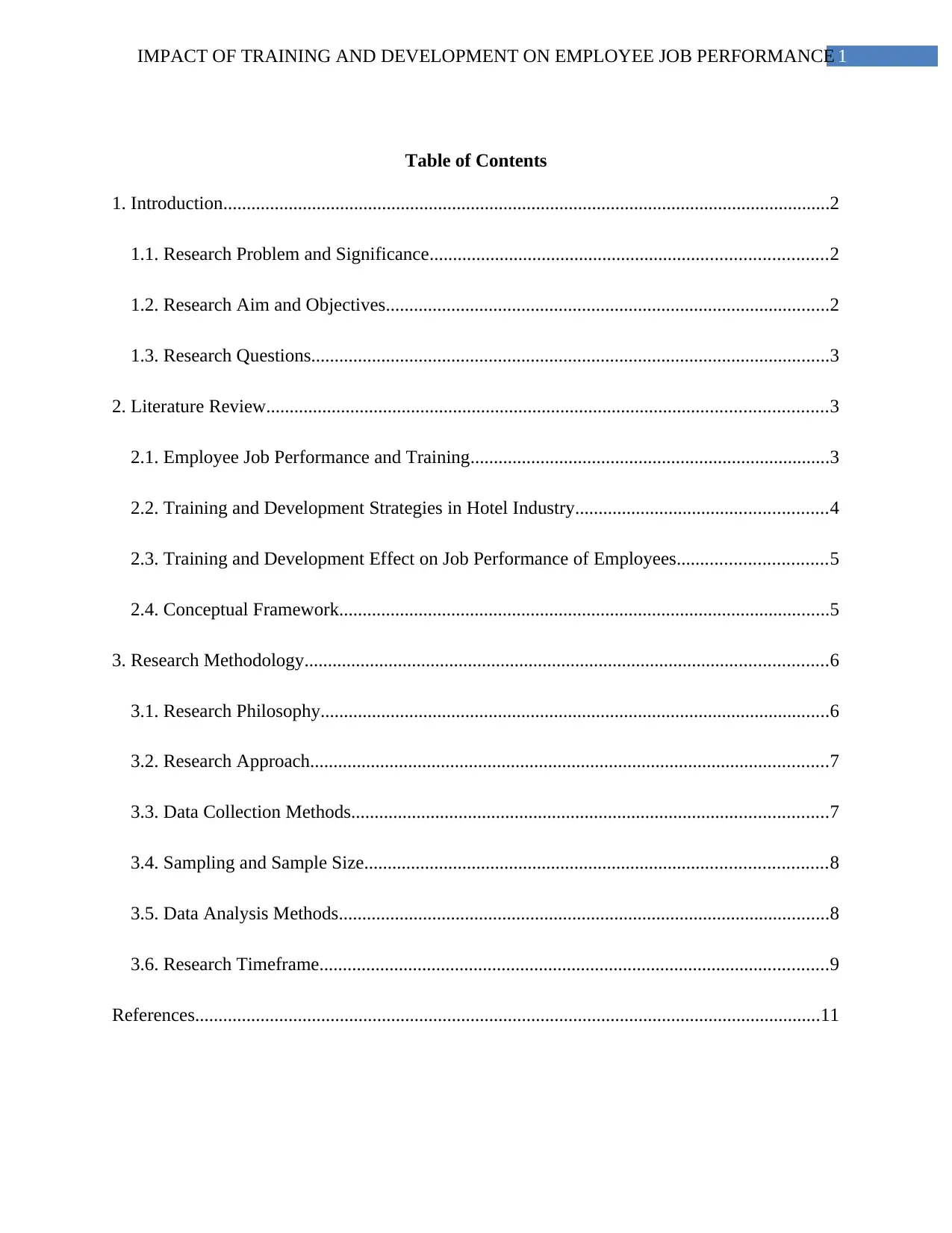
1IMPACT OF TRAINING AND DEVELOPMENT ON EMPLOYEE JOB PERFORMANCE
Table of Contents
1. Introduction..................................................................................................................................2
1.1. Research Problem and Significance.....................................................................................2
1.2. Research Aim and Objectives...............................................................................................2
1.3. Research Questions...............................................................................................................3
2. Literature Review........................................................................................................................3
2.1. Employee Job Performance and Training.............................................................................3
2.2. Training and Development Strategies in Hotel Industry......................................................4
2.3. Training and Development Effect on Job Performance of Employees................................5
2.4. Conceptual Framework.........................................................................................................5
3. Research Methodology................................................................................................................6
3.1. Research Philosophy.............................................................................................................6
3.2. Research Approach...............................................................................................................7
3.3. Data Collection Methods......................................................................................................7
3.4. Sampling and Sample Size...................................................................................................8
3.5. Data Analysis Methods.........................................................................................................8
3.6. Research Timeframe.............................................................................................................9
References......................................................................................................................................11
Table of Contents
1. Introduction..................................................................................................................................2
1.1. Research Problem and Significance.....................................................................................2
1.2. Research Aim and Objectives...............................................................................................2
1.3. Research Questions...............................................................................................................3
2. Literature Review........................................................................................................................3
2.1. Employee Job Performance and Training.............................................................................3
2.2. Training and Development Strategies in Hotel Industry......................................................4
2.3. Training and Development Effect on Job Performance of Employees................................5
2.4. Conceptual Framework.........................................................................................................5
3. Research Methodology................................................................................................................6
3.1. Research Philosophy.............................................................................................................6
3.2. Research Approach...............................................................................................................7
3.3. Data Collection Methods......................................................................................................7
3.4. Sampling and Sample Size...................................................................................................8
3.5. Data Analysis Methods.........................................................................................................8
3.6. Research Timeframe.............................................................................................................9
References......................................................................................................................................11
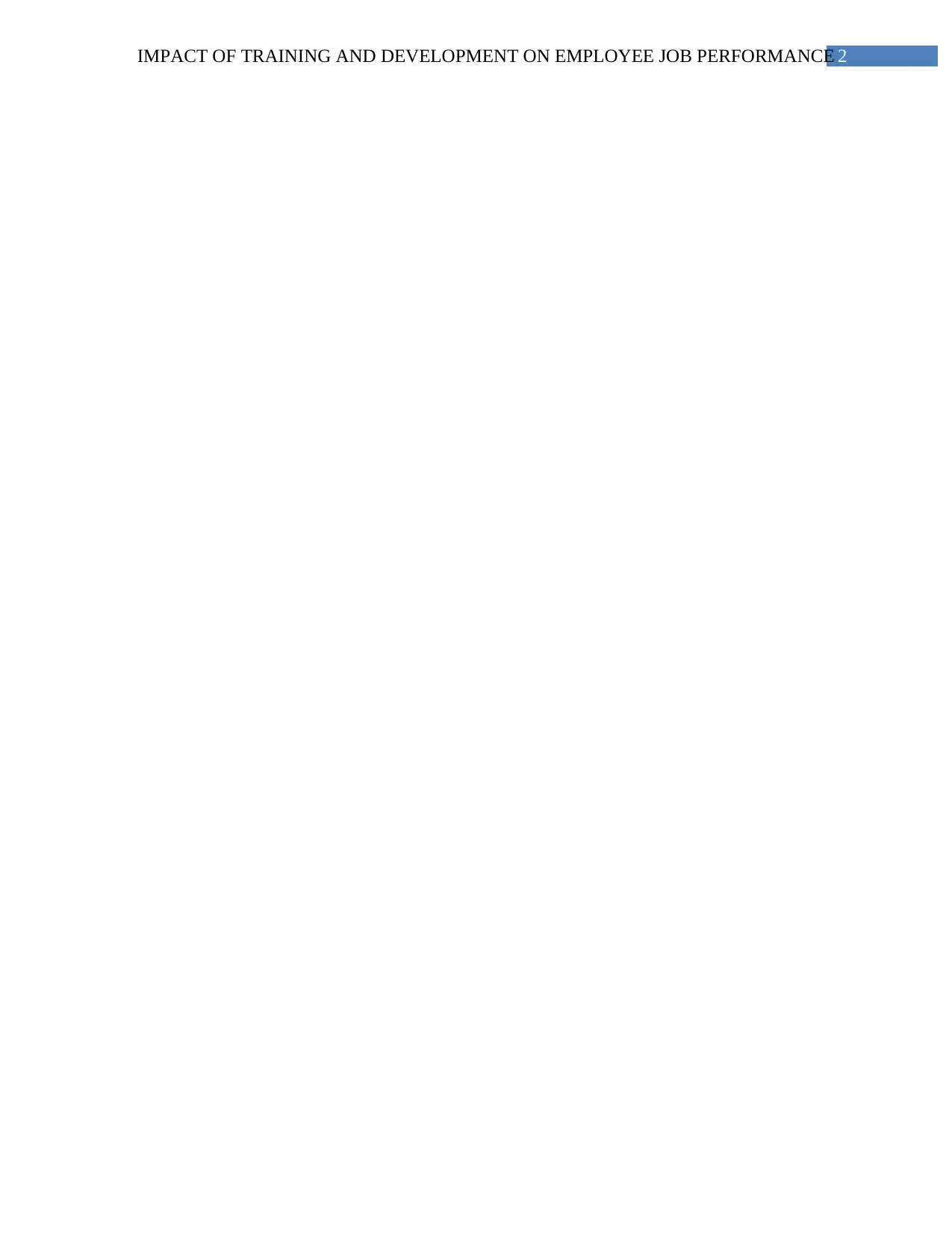
2IMPACT OF TRAINING AND DEVELOPMENT ON EMPLOYEE JOB PERFORMANCE
⊘ This is a preview!⊘
Do you want full access?
Subscribe today to unlock all pages.

Trusted by 1+ million students worldwide
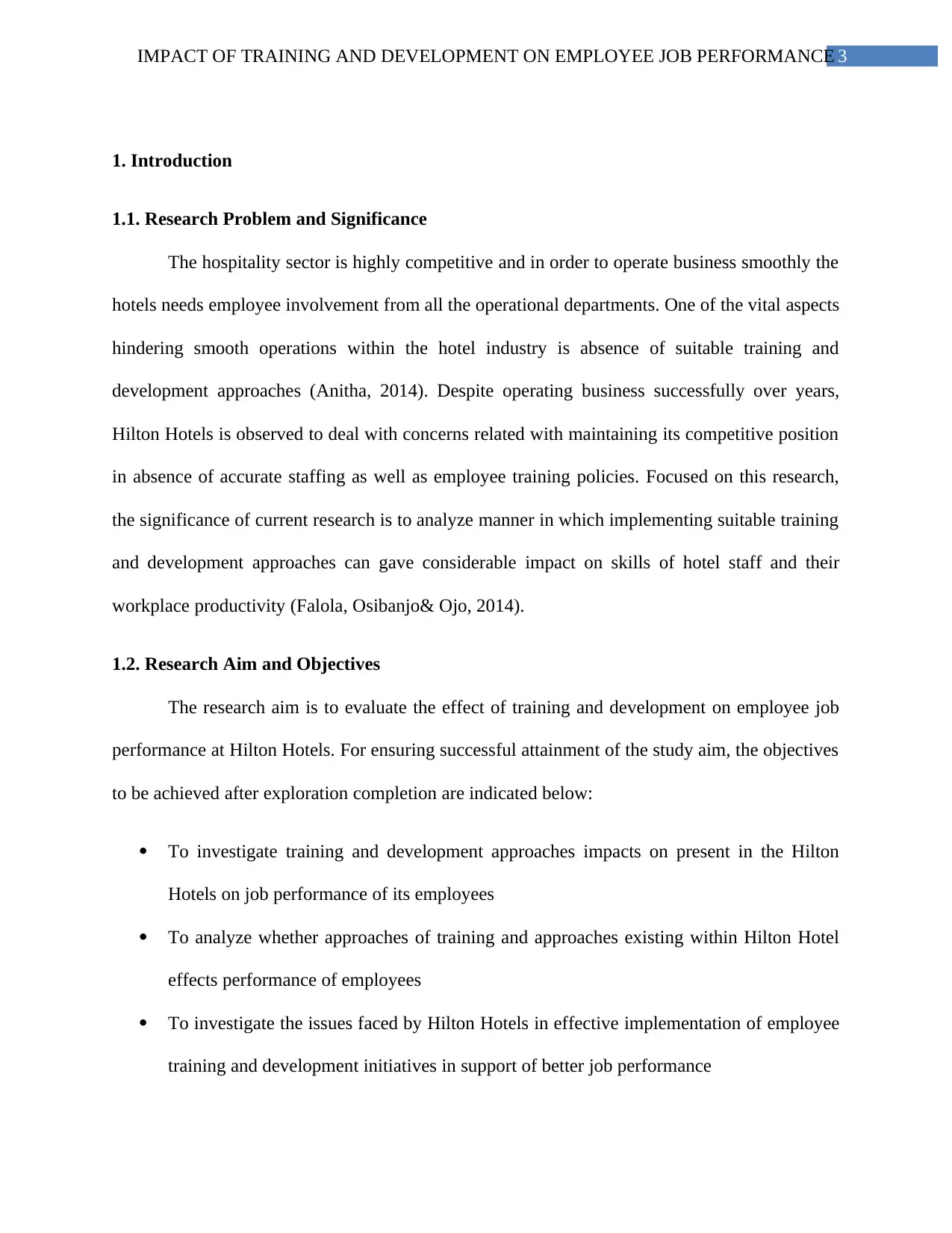
3IMPACT OF TRAINING AND DEVELOPMENT ON EMPLOYEE JOB PERFORMANCE
1. Introduction
1.1. Research Problem and Significance
The hospitality sector is highly competitive and in order to operate business smoothly the
hotels needs employee involvement from all the operational departments. One of the vital aspects
hindering smooth operations within the hotel industry is absence of suitable training and
development approaches (Anitha, 2014). Despite operating business successfully over years,
Hilton Hotels is observed to deal with concerns related with maintaining its competitive position
in absence of accurate staffing as well as employee training policies. Focused on this research,
the significance of current research is to analyze manner in which implementing suitable training
and development approaches can gave considerable impact on skills of hotel staff and their
workplace productivity (Falola, Osibanjo& Ojo, 2014).
1.2. Research Aim and Objectives
The research aim is to evaluate the effect of training and development on employee job
performance at Hilton Hotels. For ensuring successful attainment of the study aim, the objectives
to be achieved after exploration completion are indicated below:
To investigate training and development approaches impacts on present in the Hilton
Hotels on job performance of its employees
To analyze whether approaches of training and approaches existing within Hilton Hotel
effects performance of employees
To investigate the issues faced by Hilton Hotels in effective implementation of employee
training and development initiatives in support of better job performance
1. Introduction
1.1. Research Problem and Significance
The hospitality sector is highly competitive and in order to operate business smoothly the
hotels needs employee involvement from all the operational departments. One of the vital aspects
hindering smooth operations within the hotel industry is absence of suitable training and
development approaches (Anitha, 2014). Despite operating business successfully over years,
Hilton Hotels is observed to deal with concerns related with maintaining its competitive position
in absence of accurate staffing as well as employee training policies. Focused on this research,
the significance of current research is to analyze manner in which implementing suitable training
and development approaches can gave considerable impact on skills of hotel staff and their
workplace productivity (Falola, Osibanjo& Ojo, 2014).
1.2. Research Aim and Objectives
The research aim is to evaluate the effect of training and development on employee job
performance at Hilton Hotels. For ensuring successful attainment of the study aim, the objectives
to be achieved after exploration completion are indicated below:
To investigate training and development approaches impacts on present in the Hilton
Hotels on job performance of its employees
To analyze whether approaches of training and approaches existing within Hilton Hotel
effects performance of employees
To investigate the issues faced by Hilton Hotels in effective implementation of employee
training and development initiatives in support of better job performance
Paraphrase This Document
Need a fresh take? Get an instant paraphrase of this document with our AI Paraphraser
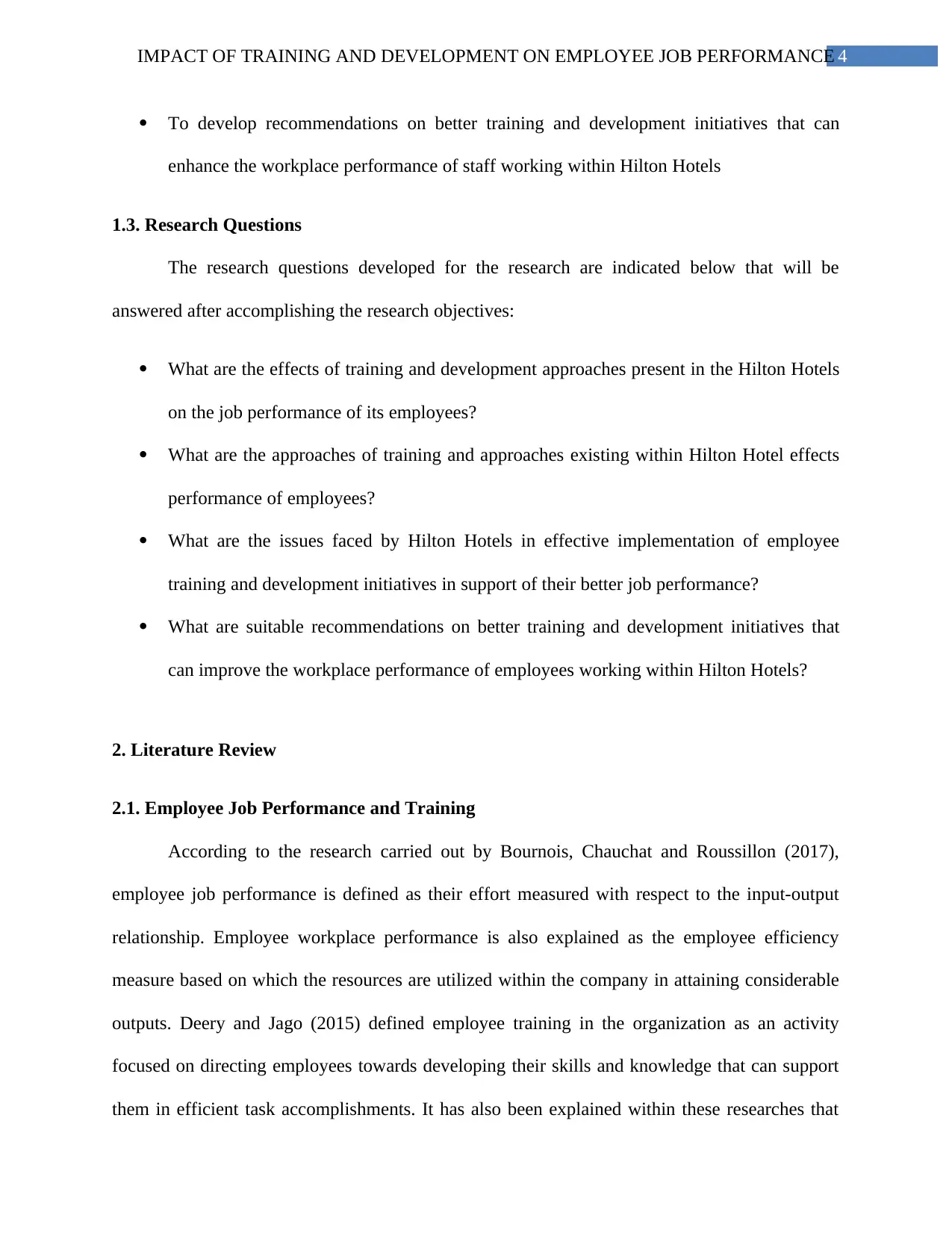
4IMPACT OF TRAINING AND DEVELOPMENT ON EMPLOYEE JOB PERFORMANCE
To develop recommendations on better training and development initiatives that can
enhance the workplace performance of staff working within Hilton Hotels
1.3. Research Questions
The research questions developed for the research are indicated below that will be
answered after accomplishing the research objectives:
What are the effects of training and development approaches present in the Hilton Hotels
on the job performance of its employees?
What are the approaches of training and approaches existing within Hilton Hotel effects
performance of employees?
What are the issues faced by Hilton Hotels in effective implementation of employee
training and development initiatives in support of their better job performance?
What are suitable recommendations on better training and development initiatives that
can improve the workplace performance of employees working within Hilton Hotels?
2. Literature Review
2.1. Employee Job Performance and Training
According to the research carried out by Bournois, Chauchat and Roussillon (2017),
employee job performance is defined as their effort measured with respect to the input-output
relationship. Employee workplace performance is also explained as the employee efficiency
measure based on which the resources are utilized within the company in attaining considerable
outputs. Deery and Jago (2015) defined employee training in the organization as an activity
focused on directing employees towards developing their skills and knowledge that can support
them in efficient task accomplishments. It has also been explained within these researches that
To develop recommendations on better training and development initiatives that can
enhance the workplace performance of staff working within Hilton Hotels
1.3. Research Questions
The research questions developed for the research are indicated below that will be
answered after accomplishing the research objectives:
What are the effects of training and development approaches present in the Hilton Hotels
on the job performance of its employees?
What are the approaches of training and approaches existing within Hilton Hotel effects
performance of employees?
What are the issues faced by Hilton Hotels in effective implementation of employee
training and development initiatives in support of their better job performance?
What are suitable recommendations on better training and development initiatives that
can improve the workplace performance of employees working within Hilton Hotels?
2. Literature Review
2.1. Employee Job Performance and Training
According to the research carried out by Bournois, Chauchat and Roussillon (2017),
employee job performance is defined as their effort measured with respect to the input-output
relationship. Employee workplace performance is also explained as the employee efficiency
measure based on which the resources are utilized within the company in attaining considerable
outputs. Deery and Jago (2015) defined employee training in the organization as an activity
focused on directing employees towards developing their skills and knowledge that can support
them in efficient task accomplishments. It has also been explained within these researches that
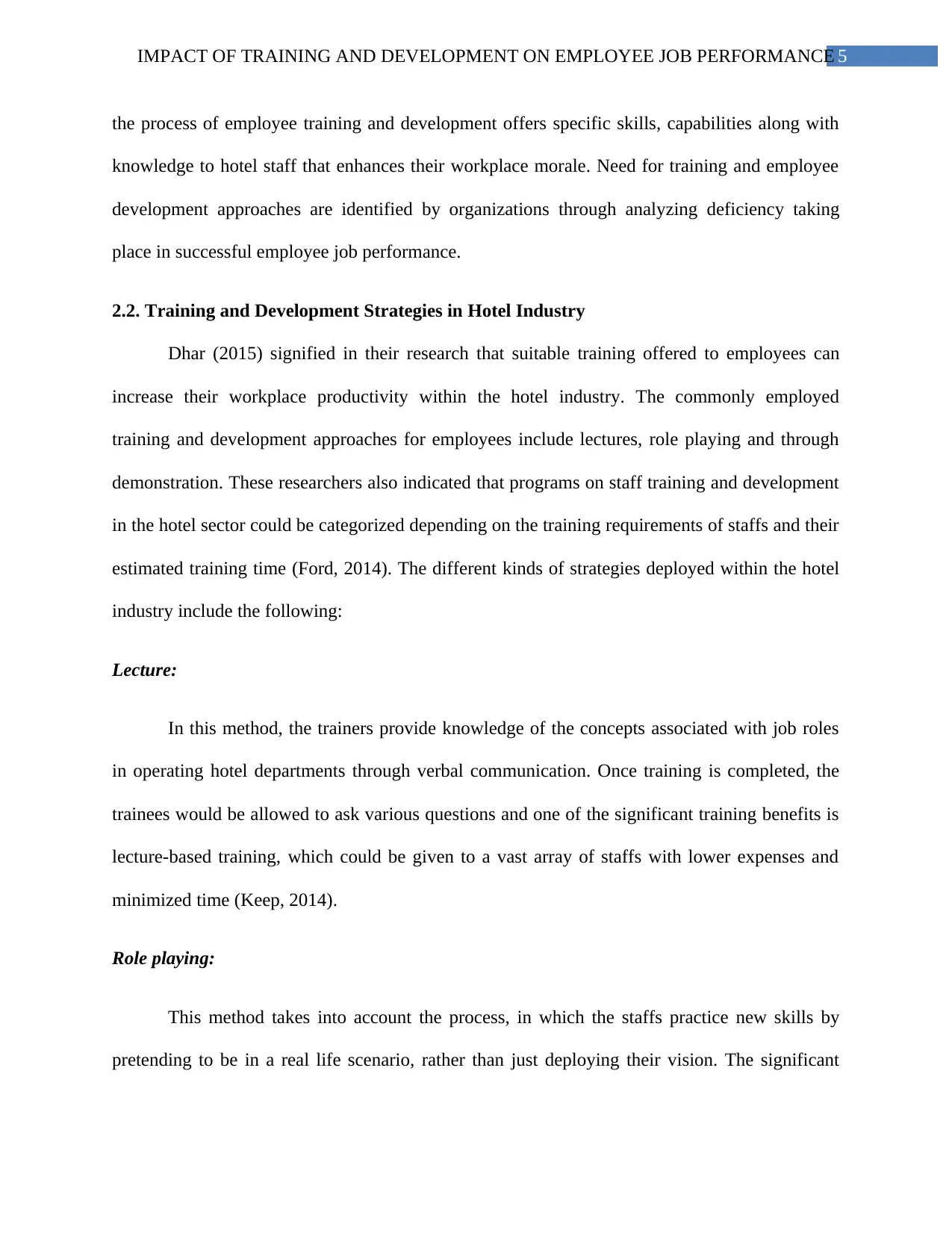
5IMPACT OF TRAINING AND DEVELOPMENT ON EMPLOYEE JOB PERFORMANCE
the process of employee training and development offers specific skills, capabilities along with
knowledge to hotel staff that enhances their workplace morale. Need for training and employee
development approaches are identified by organizations through analyzing deficiency taking
place in successful employee job performance.
2.2. Training and Development Strategies in Hotel Industry
Dhar (2015) signified in their research that suitable training offered to employees can
increase their workplace productivity within the hotel industry. The commonly employed
training and development approaches for employees include lectures, role playing and through
demonstration. These researchers also indicated that programs on staff training and development
in the hotel sector could be categorized depending on the training requirements of staffs and their
estimated training time (Ford, 2014). The different kinds of strategies deployed within the hotel
industry include the following:
Lecture:
In this method, the trainers provide knowledge of the concepts associated with job roles
in operating hotel departments through verbal communication. Once training is completed, the
trainees would be allowed to ask various questions and one of the significant training benefits is
lecture-based training, which could be given to a vast array of staffs with lower expenses and
minimized time (Keep, 2014).
Role playing:
This method takes into account the process, in which the staffs practice new skills by
pretending to be in a real life scenario, rather than just deploying their vision. The significant
the process of employee training and development offers specific skills, capabilities along with
knowledge to hotel staff that enhances their workplace morale. Need for training and employee
development approaches are identified by organizations through analyzing deficiency taking
place in successful employee job performance.
2.2. Training and Development Strategies in Hotel Industry
Dhar (2015) signified in their research that suitable training offered to employees can
increase their workplace productivity within the hotel industry. The commonly employed
training and development approaches for employees include lectures, role playing and through
demonstration. These researchers also indicated that programs on staff training and development
in the hotel sector could be categorized depending on the training requirements of staffs and their
estimated training time (Ford, 2014). The different kinds of strategies deployed within the hotel
industry include the following:
Lecture:
In this method, the trainers provide knowledge of the concepts associated with job roles
in operating hotel departments through verbal communication. Once training is completed, the
trainees would be allowed to ask various questions and one of the significant training benefits is
lecture-based training, which could be given to a vast array of staffs with lower expenses and
minimized time (Keep, 2014).
Role playing:
This method takes into account the process, in which the staffs practice new skills by
pretending to be in a real life scenario, rather than just deploying their vision. The significant
⊘ This is a preview!⊘
Do you want full access?
Subscribe today to unlock all pages.

Trusted by 1+ million students worldwide
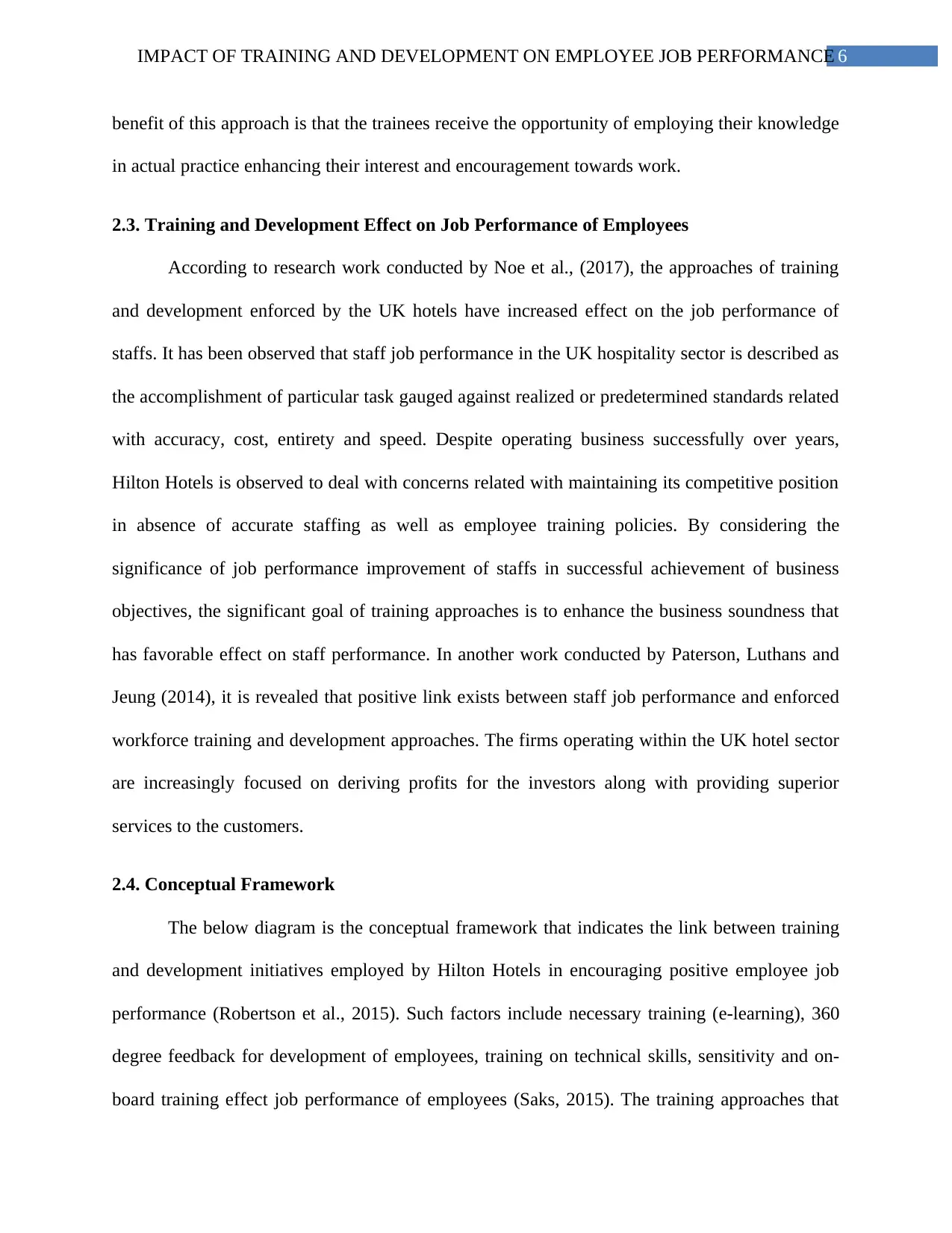
6IMPACT OF TRAINING AND DEVELOPMENT ON EMPLOYEE JOB PERFORMANCE
benefit of this approach is that the trainees receive the opportunity of employing their knowledge
in actual practice enhancing their interest and encouragement towards work.
2.3. Training and Development Effect on Job Performance of Employees
According to research work conducted by Noe et al., (2017), the approaches of training
and development enforced by the UK hotels have increased effect on the job performance of
staffs. It has been observed that staff job performance in the UK hospitality sector is described as
the accomplishment of particular task gauged against realized or predetermined standards related
with accuracy, cost, entirety and speed. Despite operating business successfully over years,
Hilton Hotels is observed to deal with concerns related with maintaining its competitive position
in absence of accurate staffing as well as employee training policies. By considering the
significance of job performance improvement of staffs in successful achievement of business
objectives, the significant goal of training approaches is to enhance the business soundness that
has favorable effect on staff performance. In another work conducted by Paterson, Luthans and
Jeung (2014), it is revealed that positive link exists between staff job performance and enforced
workforce training and development approaches. The firms operating within the UK hotel sector
are increasingly focused on deriving profits for the investors along with providing superior
services to the customers.
2.4. Conceptual Framework
The below diagram is the conceptual framework that indicates the link between training
and development initiatives employed by Hilton Hotels in encouraging positive employee job
performance (Robertson et al., 2015). Such factors include necessary training (e-learning), 360
degree feedback for development of employees, training on technical skills, sensitivity and on-
board training effect job performance of employees (Saks, 2015). The training approaches that
benefit of this approach is that the trainees receive the opportunity of employing their knowledge
in actual practice enhancing their interest and encouragement towards work.
2.3. Training and Development Effect on Job Performance of Employees
According to research work conducted by Noe et al., (2017), the approaches of training
and development enforced by the UK hotels have increased effect on the job performance of
staffs. It has been observed that staff job performance in the UK hospitality sector is described as
the accomplishment of particular task gauged against realized or predetermined standards related
with accuracy, cost, entirety and speed. Despite operating business successfully over years,
Hilton Hotels is observed to deal with concerns related with maintaining its competitive position
in absence of accurate staffing as well as employee training policies. By considering the
significance of job performance improvement of staffs in successful achievement of business
objectives, the significant goal of training approaches is to enhance the business soundness that
has favorable effect on staff performance. In another work conducted by Paterson, Luthans and
Jeung (2014), it is revealed that positive link exists between staff job performance and enforced
workforce training and development approaches. The firms operating within the UK hotel sector
are increasingly focused on deriving profits for the investors along with providing superior
services to the customers.
2.4. Conceptual Framework
The below diagram is the conceptual framework that indicates the link between training
and development initiatives employed by Hilton Hotels in encouraging positive employee job
performance (Robertson et al., 2015). Such factors include necessary training (e-learning), 360
degree feedback for development of employees, training on technical skills, sensitivity and on-
board training effect job performance of employees (Saks, 2015). The training approaches that
Paraphrase This Document
Need a fresh take? Get an instant paraphrase of this document with our AI Paraphraser
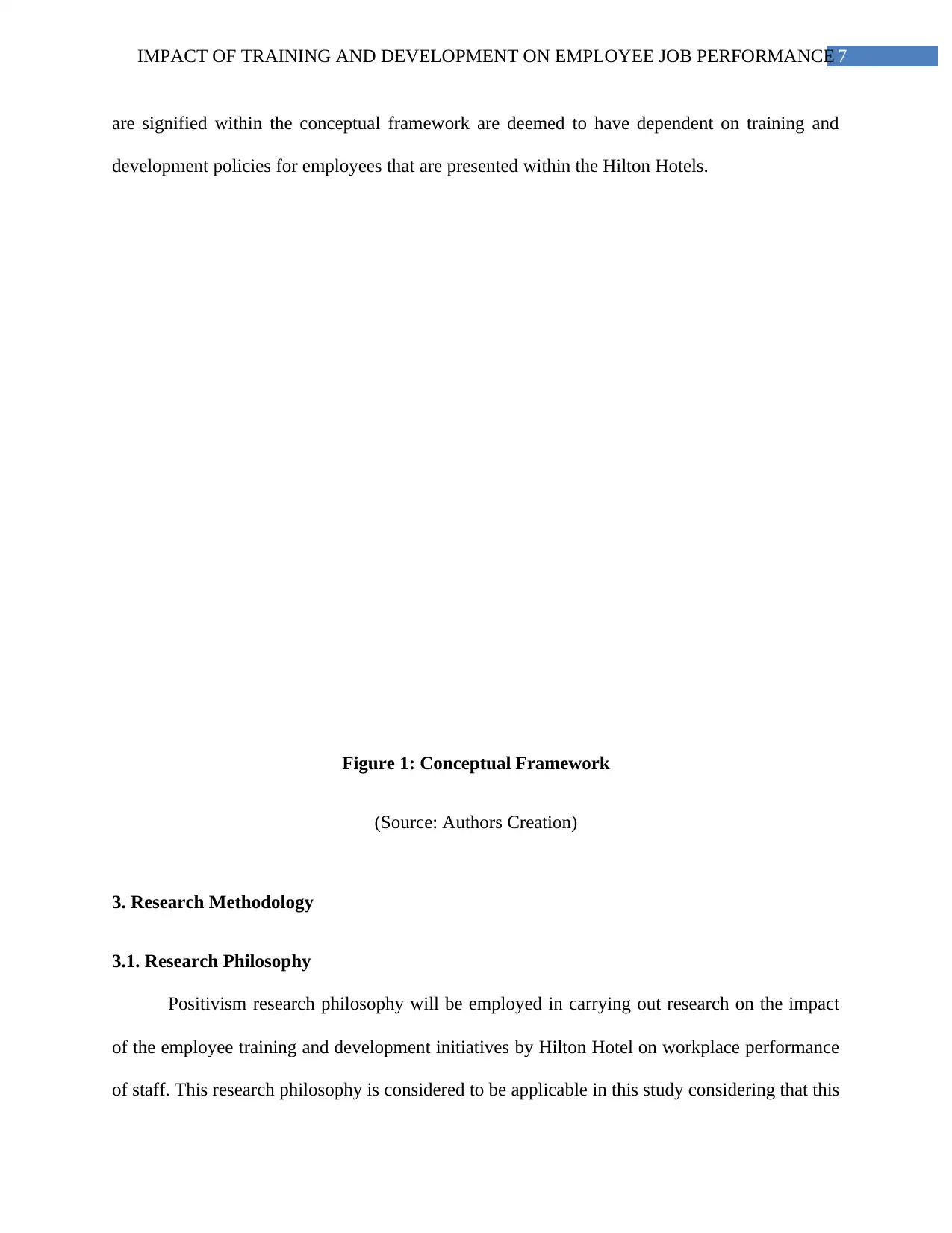
7IMPACT OF TRAINING AND DEVELOPMENT ON EMPLOYEE JOB PERFORMANCE
are signified within the conceptual framework are deemed to have dependent on training and
development policies for employees that are presented within the Hilton Hotels.
Figure 1: Conceptual Framework
(Source: Authors Creation)
3. Research Methodology
3.1. Research Philosophy
Positivism research philosophy will be employed in carrying out research on the impact
of the employee training and development initiatives by Hilton Hotel on workplace performance
of staff. This research philosophy is considered to be applicable in this study considering that this
are signified within the conceptual framework are deemed to have dependent on training and
development policies for employees that are presented within the Hilton Hotels.
Figure 1: Conceptual Framework
(Source: Authors Creation)
3. Research Methodology
3.1. Research Philosophy
Positivism research philosophy will be employed in carrying out research on the impact
of the employee training and development initiatives by Hilton Hotel on workplace performance
of staff. This research philosophy is considered to be applicable in this study considering that this
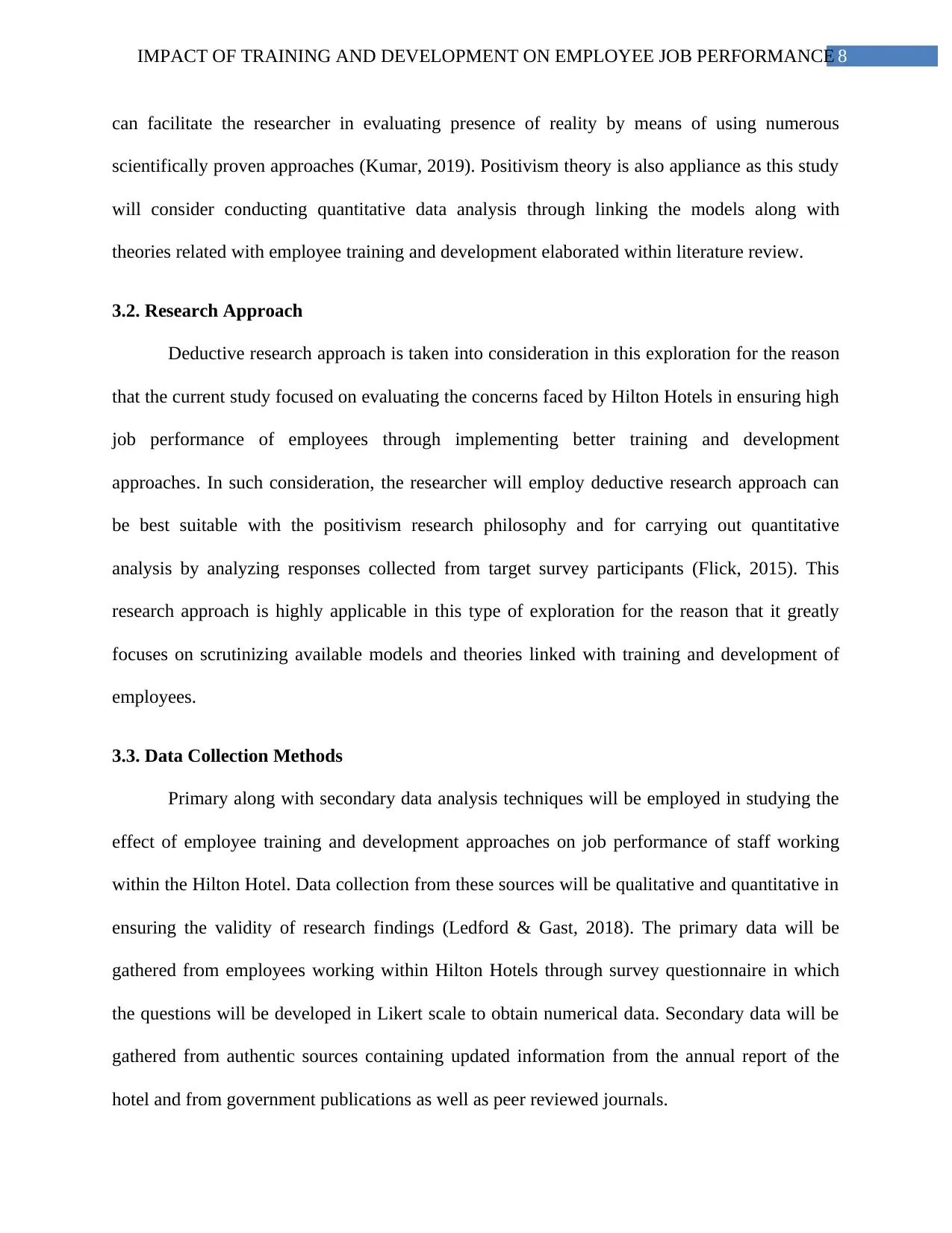
8IMPACT OF TRAINING AND DEVELOPMENT ON EMPLOYEE JOB PERFORMANCE
can facilitate the researcher in evaluating presence of reality by means of using numerous
scientifically proven approaches (Kumar, 2019). Positivism theory is also appliance as this study
will consider conducting quantitative data analysis through linking the models along with
theories related with employee training and development elaborated within literature review.
3.2. Research Approach
Deductive research approach is taken into consideration in this exploration for the reason
that the current study focused on evaluating the concerns faced by Hilton Hotels in ensuring high
job performance of employees through implementing better training and development
approaches. In such consideration, the researcher will employ deductive research approach can
be best suitable with the positivism research philosophy and for carrying out quantitative
analysis by analyzing responses collected from target survey participants (Flick, 2015). This
research approach is highly applicable in this type of exploration for the reason that it greatly
focuses on scrutinizing available models and theories linked with training and development of
employees.
3.3. Data Collection Methods
Primary along with secondary data analysis techniques will be employed in studying the
effect of employee training and development approaches on job performance of staff working
within the Hilton Hotel. Data collection from these sources will be qualitative and quantitative in
ensuring the validity of research findings (Ledford & Gast, 2018). The primary data will be
gathered from employees working within Hilton Hotels through survey questionnaire in which
the questions will be developed in Likert scale to obtain numerical data. Secondary data will be
gathered from authentic sources containing updated information from the annual report of the
hotel and from government publications as well as peer reviewed journals.
can facilitate the researcher in evaluating presence of reality by means of using numerous
scientifically proven approaches (Kumar, 2019). Positivism theory is also appliance as this study
will consider conducting quantitative data analysis through linking the models along with
theories related with employee training and development elaborated within literature review.
3.2. Research Approach
Deductive research approach is taken into consideration in this exploration for the reason
that the current study focused on evaluating the concerns faced by Hilton Hotels in ensuring high
job performance of employees through implementing better training and development
approaches. In such consideration, the researcher will employ deductive research approach can
be best suitable with the positivism research philosophy and for carrying out quantitative
analysis by analyzing responses collected from target survey participants (Flick, 2015). This
research approach is highly applicable in this type of exploration for the reason that it greatly
focuses on scrutinizing available models and theories linked with training and development of
employees.
3.3. Data Collection Methods
Primary along with secondary data analysis techniques will be employed in studying the
effect of employee training and development approaches on job performance of staff working
within the Hilton Hotel. Data collection from these sources will be qualitative and quantitative in
ensuring the validity of research findings (Ledford & Gast, 2018). The primary data will be
gathered from employees working within Hilton Hotels through survey questionnaire in which
the questions will be developed in Likert scale to obtain numerical data. Secondary data will be
gathered from authentic sources containing updated information from the annual report of the
hotel and from government publications as well as peer reviewed journals.
⊘ This is a preview!⊘
Do you want full access?
Subscribe today to unlock all pages.

Trusted by 1+ million students worldwide
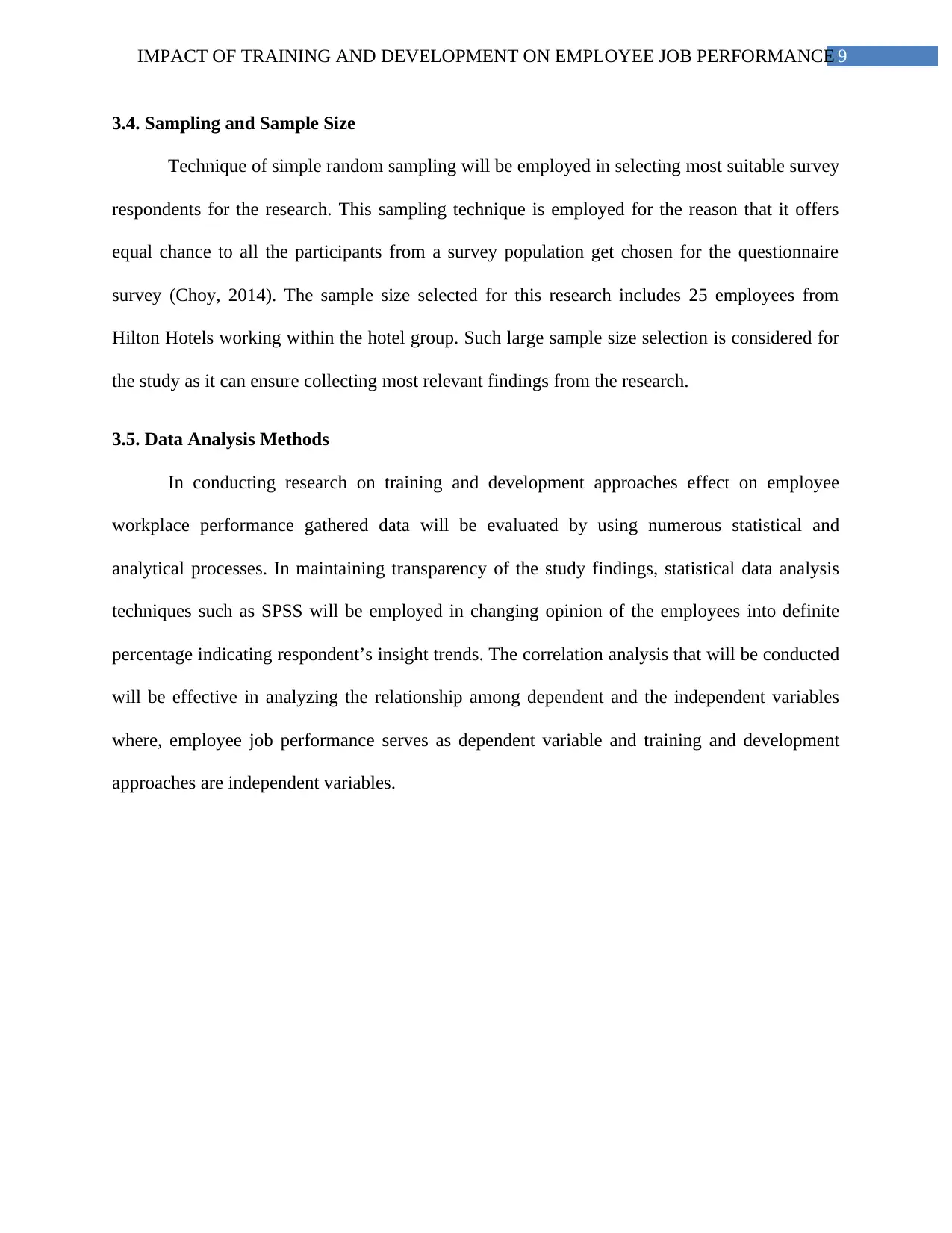
9IMPACT OF TRAINING AND DEVELOPMENT ON EMPLOYEE JOB PERFORMANCE
3.4. Sampling and Sample Size
Technique of simple random sampling will be employed in selecting most suitable survey
respondents for the research. This sampling technique is employed for the reason that it offers
equal chance to all the participants from a survey population get chosen for the questionnaire
survey (Choy, 2014). The sample size selected for this research includes 25 employees from
Hilton Hotels working within the hotel group. Such large sample size selection is considered for
the study as it can ensure collecting most relevant findings from the research.
3.5. Data Analysis Methods
In conducting research on training and development approaches effect on employee
workplace performance gathered data will be evaluated by using numerous statistical and
analytical processes. In maintaining transparency of the study findings, statistical data analysis
techniques such as SPSS will be employed in changing opinion of the employees into definite
percentage indicating respondent’s insight trends. The correlation analysis that will be conducted
will be effective in analyzing the relationship among dependent and the independent variables
where, employee job performance serves as dependent variable and training and development
approaches are independent variables.
3.4. Sampling and Sample Size
Technique of simple random sampling will be employed in selecting most suitable survey
respondents for the research. This sampling technique is employed for the reason that it offers
equal chance to all the participants from a survey population get chosen for the questionnaire
survey (Choy, 2014). The sample size selected for this research includes 25 employees from
Hilton Hotels working within the hotel group. Such large sample size selection is considered for
the study as it can ensure collecting most relevant findings from the research.
3.5. Data Analysis Methods
In conducting research on training and development approaches effect on employee
workplace performance gathered data will be evaluated by using numerous statistical and
analytical processes. In maintaining transparency of the study findings, statistical data analysis
techniques such as SPSS will be employed in changing opinion of the employees into definite
percentage indicating respondent’s insight trends. The correlation analysis that will be conducted
will be effective in analyzing the relationship among dependent and the independent variables
where, employee job performance serves as dependent variable and training and development
approaches are independent variables.
Paraphrase This Document
Need a fresh take? Get an instant paraphrase of this document with our AI Paraphraser
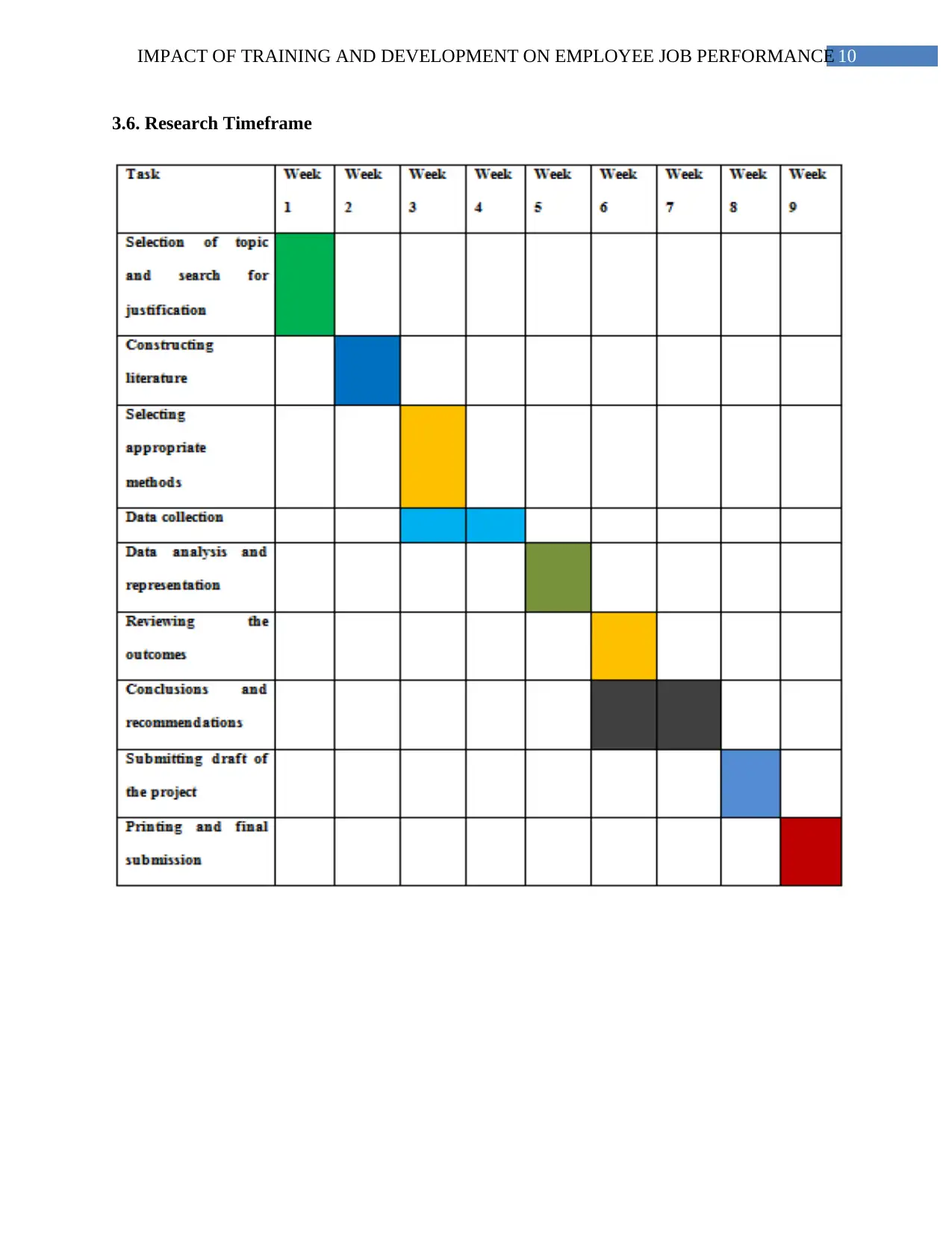
10IMPACT OF TRAINING AND DEVELOPMENT ON EMPLOYEE JOB PERFORMANCE
3.6. Research Timeframe
3.6. Research Timeframe
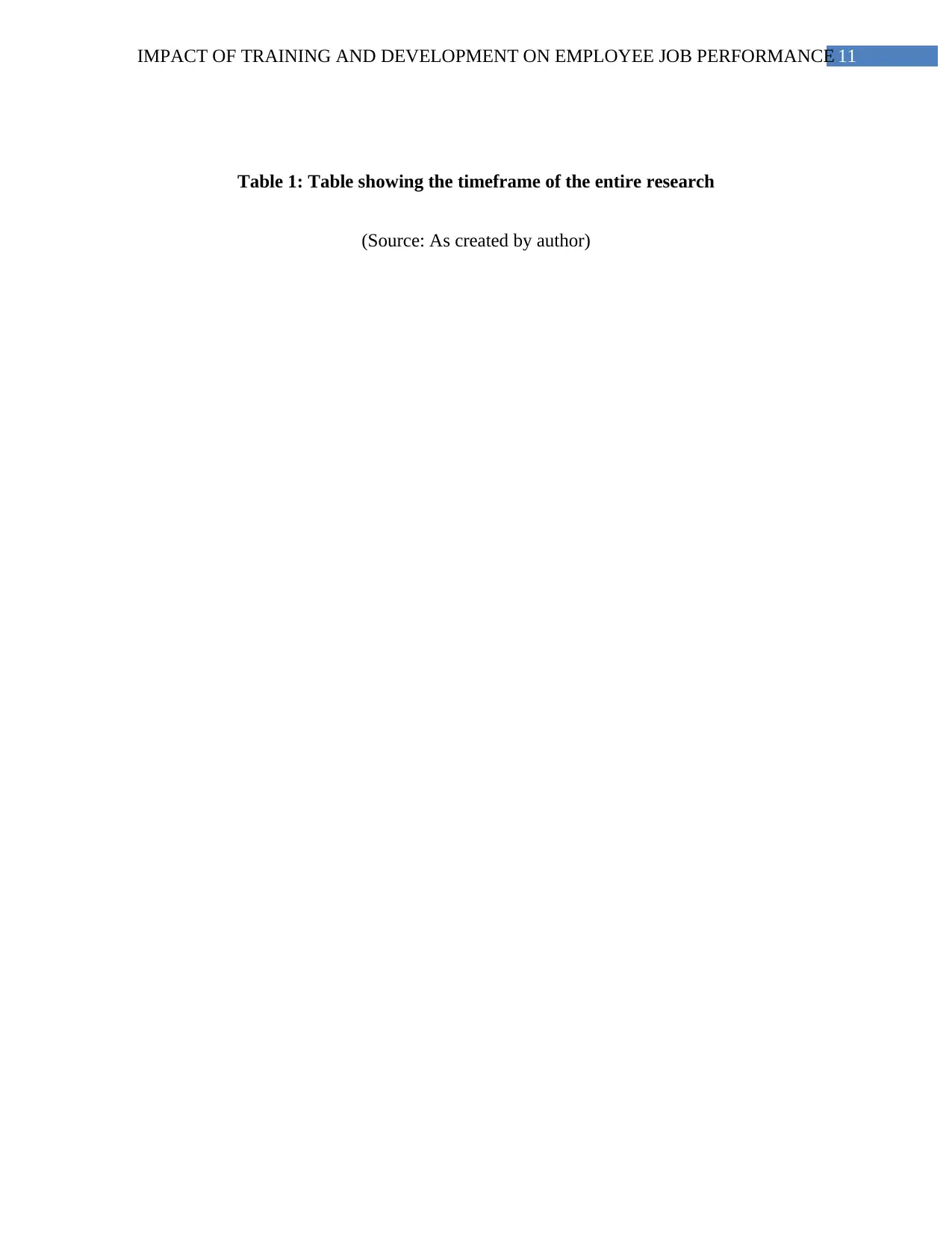
11IMPACT OF TRAINING AND DEVELOPMENT ON EMPLOYEE JOB PERFORMANCE
Table 1: Table showing the timeframe of the entire research
(Source: As created by author)
Table 1: Table showing the timeframe of the entire research
(Source: As created by author)
⊘ This is a preview!⊘
Do you want full access?
Subscribe today to unlock all pages.

Trusted by 1+ million students worldwide
1 out of 14
Related Documents
Your All-in-One AI-Powered Toolkit for Academic Success.
+13062052269
info@desklib.com
Available 24*7 on WhatsApp / Email
![[object Object]](/_next/static/media/star-bottom.7253800d.svg)
Unlock your academic potential
Copyright © 2020–2025 A2Z Services. All Rights Reserved. Developed and managed by ZUCOL.





